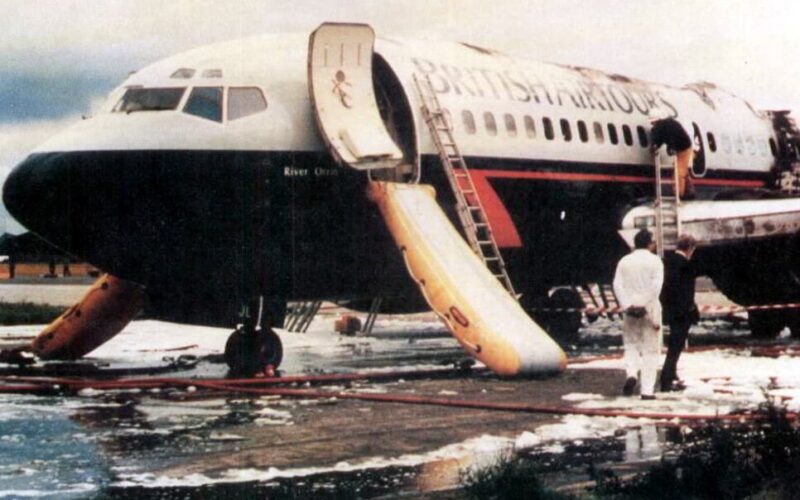During the morning of August 22, 1985, British Airtours Flight 28M, a Boeing 737-200, was scheduled to depart Manchester Airport, England, for Corfu, Greece, carrying 131 passengers and six crew.
At 06:12hrs (UTC), while accelerating on take-off, a loud ‘thud’ was heard. The pilots, believing it was a burst tire, abandoned the take-off. Around nine seconds later, fire warnings sounded on the flight deck, and ATC confirmed there was a serious fire from the left engine.
The pilots vacated the runway and came to a stop before an evacuation was initiated, but the aircraft and cabin were soon engulfed in fire and thick black smoke. Within minutes, the Boeing 737 was destroyed and 53 passengers and two crew were killed in what remains one of Britain’s deadliest aviation disasters.
The accident became a catalyst for improving aviation safety. The changes, which have since been implemented, are still visible today and have saved countless lives in similar accidents.
Engine failure and fire
Investigators found that the accident was caused by a combustor can in the left engine. This ruptured, ejecting shrapnel from the engine, which pierced the fuel tank on the underside of the wing, causing fuel to pour onto the engine and fueling the fire.
As the aircraft turned off the runway and came to a stop on taxiway delta, the 737 and its burning engine were no longer aligned parallel to the wind. Now with a crosswind component, the fire and smoke were being blown directly onto the aircraft’s fuselage.
Evacuation
The captain advised over the PA that passengers should be evacuated from the right-hand side of the aircraft. The purser attempted to open Door 1R, but a design fault caused the slide to deploy prematurely, and the door became jammed. The purser then opened Door 1L and began evacuating, before returning to Door 1R and forcing it open.
Once the doors were open, the panicked rush of passengers caused bottlenecks in the narrow aisle between two bulkheads in the galley. The cabin crew were forced to repeatedly remove passengers from the aisle to free the blockages. In total, 52 of the 82 survivors escaped using the forward two doors.
At the rear of aircraft, Door 2R was opened, but with the dense smoke and flames being carried across the fuselage it was not used. Door 2L was never opened and subsequently no passengers escaped using the two main rear doors.
At the overwing exits, further problems were encountered. The left side was unusable due to the left wing being consumed by fire and smoke.
On the right-side, the passenger did not understand how to open the overwing exit. When it was finally opened, the door’s heavy weight trapped the passenger before it was moved, and the exit made clear.
The lack of space in the exit rows also impeded evacuation. In the panic, armrests and collapsed seat backs presented obstacles for the passengers trying to escape.
For 100 of the 131 passengers on board, the right overwing door was the nearest usable exit, via which, tragically, only 27 managed to escape. It was also where most of the bodies were found by rescuers having been overwhelmed by toxic smoke.
It became clear that changes were necessary to prevent a reoccurrence of this accident. The investigation focused on why there was such a high death rate when, despite the engine fire, the aircraft was initially intact and had never left the ground.
Improving evacuation
The investigators highlighted overwing exits, which at the time were the same width as standard rows. Following the disaster, exit rows were made wider to allow for an easier and faster evacuation.
It also became mandatory for cabin crew to brief passengers in these rows prior to departure about their responsibility for opening the doors in the event of an evacuation.
Today, no baggage or items that could impede evacuation are allowed during take-off and landing in exit rows, and there are also categories of passengers who cannot occupy the seats based on their ability to open the doors.
In case of poor visibility in the cabin, emergency floor lighting was introduced on aircraft, guiding passengers at floor level to the exits.
Materials used in the cabin were changed as investigators found that the seat cushions, floor carpets and plastic interiors released poisonous cyanide and carbon monoxide gases.
The bulkheads separating the cabin and galleys were reduced in size, increasing the isle width to prevent bottlenecks. Boeing also rectified the fault with the main doors, inhibiting the slides from deploying prematurely.
Finally, it is now standard practice that in the event of a rejected take-off, the aircraft stops on the runway giving the best chance of facing into wind.
Aftermath
The crew on Flight 28M, along with the firefighters at Manchester Airport, were highly commended for both their bravery and devotion to duty, which saved many more lives.
August 1985 remains the deadliest month in aviation history, but the lessons have served to vastly improve safety within the industry.
In October 2016, 31 years after the British Airtours disaster, American Airlines Flight 383 suffered an uncontained engine failure and fire on take-off at Chicago O’Hare airport in almost identical circumstances to the events at Manchester on August 22, 1985.
All 170 passengers and crew evacuated without a single fatality.
This article was first published on September 18, 2022.

